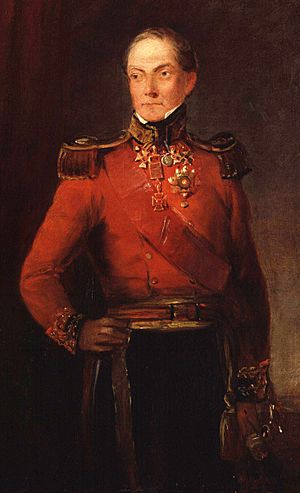James Kempt facts for kids
Quick facts for kids
Sir James Kempt
|
|
|---|---|
 |
|
| Nickname(s) | Anne |
| Born | c. 1765 Edinburgh, Scotland |
| Died | 20 December 1854 London, England |
| Allegiance | United Kingdom |
| Service/ |
British Army |
| Rank | General |
| Commands held | South-West District 8th Brigade |
| Battles/wars | War of the Third Coalition Peninsular War War of 1812 War of the Seventh Coalition |
| Awards | Knight Grand Cross of the Order of the Bath Knight Grand Cross of the Royal Guelphic Order |
General Sir James Kempt (born around 1765 – died 20 December 1854) was an important officer in the British Army. He fought in many wars, including the Napoleonic Wars in places like the Netherlands, Egypt, and Italy. He also served in North America. Sir James Kempt is famous for leading a British brigade at the Battle of Waterloo. Later in his life, he became the Governor General of Canada.
Contents
Early Military Career
James Kempt was born in Edinburgh, Scotland, around the year 1765. His father was Gavin Kempt.
He started his army career in 1783 with the 101st Grenadiers in India. However, this regiment was soon disbanded. For a short time, he worked as a clerk. He caught the attention of the Duke of York, a very important person. Thanks to the Duke, Kempt quickly became a captain and then a major in a new regiment called the 113th Foot. This regiment also didn't last long, but Kempt stayed in the army, helping with recruitment.
In 1799, Kempt went with Sir Ralph Abercromby to the Netherlands. He then went to Egypt as an aide-de-camp, which means he was a personal assistant to a senior officer. After Sir Ralph Abercromby died, Kempt continued to serve on the staff of the new commander. In 1803, he became a lieutenant colonel in the 81st Foot regiment. He went with his new regiment to the Mediterranean region. At the Battle of Maida in 1806, he led a group of light infantry soldiers. They faced some of the toughest fighting in that battle.
Fighting in the Peninsular War
From 1807 to 1811, Kempt worked in North America. At the end of 1811, he joined Wellington's army in Spain. He was given the rank of major general.
As one of Thomas Picton's brigadiers, Kempt played a key role in the big attack on Badajoz. He was badly wounded during this battle. After he recovered, he was given command of a brigade in the Light Division. This group included brave soldiers from the 43rd Regiment of Foot, the 95th Rifles, and Portuguese Light Infantry. He led them in the Battle of Vitoria in 1813.
Kempt also led his brigade in the Battle of the Pyrenees and the Battle of the Bidassoa. At Bidassoa, his troops bravely stormed French defenses. He was wounded again while leading his brigade at the Battle of Nivelle. In 1814, he led his brigade in the battles of Orthez and Toulouse.
Canada and the Battle of Waterloo
After Napoleon Bonaparte gave up his power for the first time, Kempt was sent back to North America. The War of 1812 between Britain and America was still happening there. He was supposed to lead a brigade to attack an important American base. However, problems with supplies stopped the attack. News of peace between Britain and America arrived in 1815, and Kempt returned to Europe.
Kempt was chosen to lead the 8th British Brigade in the army that Wellington put together in Belgium. This army was preparing to invade France. Kempt's brigade included soldiers from the 28th, 32nd, 79th Highland, and 95th Rifles regiments. They were part of Sir Thomas Picton's 5th Division.
At the Battle of Quatre Bras, Kempt's brigade fought very hard. Many soldiers were killed or wounded. At the famous Battle of Waterloo on 18 June, his brigade was again in the middle of the fighting. They suffered many more casualties. When Picton died during the battle, Kempt took over command of the entire division.
For his bravery and service, Kempt received important awards. In 1815, he was made a Knight Commander of the Order of the Bath. In July, for his actions at Waterloo, he became a Knight Grand Cross of the Order of the Bath. The Dutch King also made him a Knight in the Military Order of William.
Later, he became the Lieutenant-Governor of Portsmouth. From 1828 to 1830, he served as the Governor of British North America. This was a difficult time, but he showed strong and fair leadership. He later became the Master-General of the Ordnance, a high-ranking military position. Sir James Kempt died in London in 1854.
Places Named After Him
Several places are named in honor of Sir James Kempt:
 Nova Scotia: Kemptville, Kempt Shore, Kempt, Kempt Road in Halifax, and Kempt Street in Lunenburg.
Nova Scotia: Kemptville, Kempt Shore, Kempt, Kempt Road in Halifax, and Kempt Street in Lunenburg. Ontario: Kemptville.
Ontario: Kemptville.- Kempt Tower, Jersey.

